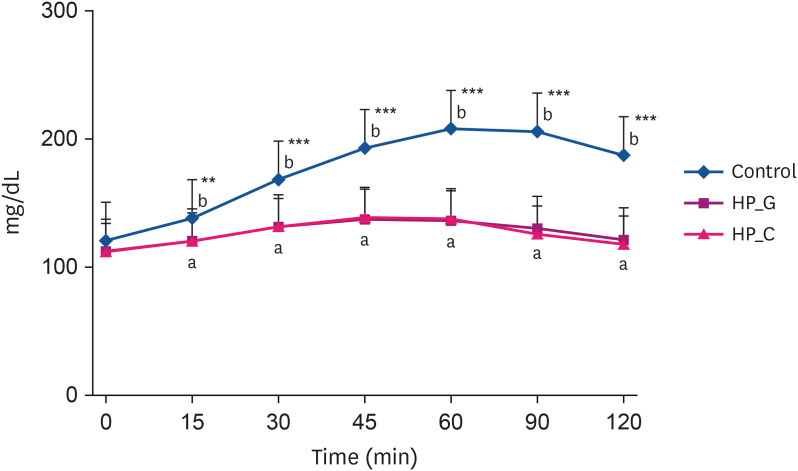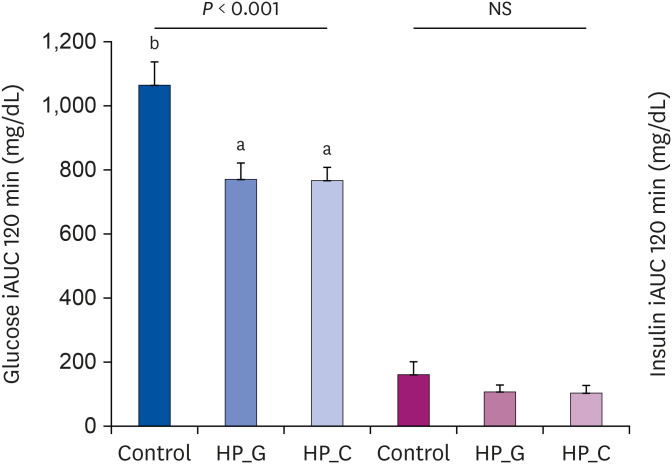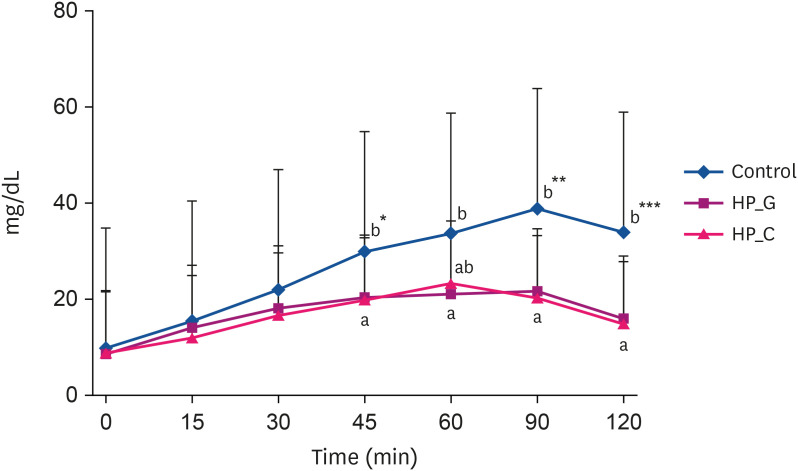Nutr Res Pract.
2021 Feb;15(1):54-65. 10.4162/nrp.2021.15.1.54.
Changes in the glucose and insulin responses according to high-protein snacks for diabetic patients
- Affiliations
-
- 1Department of Nutritional Science and Food Management, Ewha Womans University, Seoul 03760, Korea
- 2Division of Endocrinology and Metabolism, Department of Internal Medicine, Seoul Medical Center, Seoul 02053, Korea
- 3College of Science & Industry Convergence, Ewha Womans University, Seoul 03760, Korea
- KMID: 2511673
- DOI: http://doi.org/10.4162/nrp.2021.15.1.54
Abstract
- BACKGROUND/OBJECTIVES
This study aimed to develop healthy, appetizing high-protein snacks with enhanced isolated soy protein for diabetic patients and determine the blood glucose and insulin response after being consumed by these patients.
MATERIALS/METHODS
Thirty adult patients aged between 30 and 75 years, with a ≤ 10-year history of type 2 diabetes and hemoglobin A1c of < 7.5%, were enrolled in this study. They made 3 clinical visits at one-week intervals. The control group consumed 50 g carbohydrates (white bread), whereas the test groups consumed high-protein grain (HP_G) or high-protein chocolate (HP_C) after an 8-hrs fast. Blood (2 cm 3 ) was drawn at 15, 30, 45, 60, 90, and 120 min before and after consumption to analyze the blood glucose and insulin concentrations.
RESULTS
Compared to the commercial snacks, the developed high-protein snacks had belowaverage calorie, carbohydrate, and fat content and a 2.5-fold higher protein content. In diabetic patients who consumed these snacks, the postprandial blood glucose increased between 15 min and 2 h after consumption, which was significantly slower than the time taken for the blood glucose to increase in the patients who consumed the control food product (P< 0.001). Insulin secretion was significantly lower at 45 min after consumption (P < 0.05), showing that the highprotein snacks did not increase the blood glucose levels rapidly. The incremental area under the curve (iAUC), which indicated the degree of blood sugar and insulin elevation after food intake, was higher in the control group than the groups given the 2 developed snacks (P < 0.001), and there was no significant difference in insulin secretion.
CONCLUSIONS
The results of the postprandial blood glucose and insulin response suggest that high-protein snacks are potential convenient sources of high-quality protein and serve as a healthier alternative for patients with type 2 diabetes, who may have limited snack product choices. Such snacks may also provide balanced nutrition to pre-diabetic and obese individuals.
Keyword
Figure
Reference
-
1. Korea Centers for Disease Control and Prevention. 2017 National Health Statistics [Internet]. Cheongju: Korea Centers for Disease Control and Prevention;2019. cited 2019 January 11. Available from: https://knhanes.cdc.go.kr/knhanes/sub04/sub04_03.do?classType=7.2. Gross LS, Li L, Ford ES, Liu S. Increased consumption of refined carbohydrates and the epidemic of type 2 diabetes in the United States: an ecologic assessment. Am J Clin Nutr. 2004; 79:774–779. PMID: 15113714.
Article3. Ahn SE. An effective method to provide sugar reduction information of a sugar reduced beverage: focusing on food related lifestyle and eye tracking experiment [master's thesis]. Seoul: Ewha Womans University;2018.4. Korea Agro-Fisheries & Food Trade Corporation. 2016 Food Information Statistics System [Internet]. Naju: Korea Agro-Fisheries & Food Trade Corporation;2017. cited 2017 March 14. Available from: https://www.atfis.or.kr/article/M001050000/view.do?articleId=2435&page=&searchKey=subject&searchString=%EA%B3%BC%EC%9E%90%EB%A5%98&searchCategory.5. Ahn SE, Oh JE, Cho MS. Effects of cognition toward fresh pear on the purchase of pear and processed pear products. J Korean Soc Food Cult. 2017; 32:394–402.6. Park HR. Quality characteristics and preference of high protein cookies with various isolated soybean protein and whey protein mixing ratios [master's thesis]. Seoul: Ewha Womans University;2018.7. Park GS, Ly SY. Compliance and need assessment for diet therapy among diabetics and their caregivers. Korean J Community Nutr. 2003; 8:91–101.8. Mathew R, Gucciardi E, De Melo M, Barata P. Self-management experiences among men and women with type 2 diabetes mellitus: a qualitative analysis. BMC Fam Pract. 2012; 13:122. PMID: 23249410.
Article9. Ranasinghe P, Pigera AS, Ishara MH, Jayasekara LM, Jayawardena R, Katulanda P. Knowledge and perceptions about diet and physical activity among Sri Lankan adults with diabetes mellitus: a qualitative study. BMC Public Health. 2015; 15:1160. PMID: 26597081.
Article10. Hong GJ, Lee HJ. Physical and sensory characteristics of cookies with sugar substitutes. Culin Sci Hosp Res. 2020; 26:160–167.11. Ministry of Food and Drug Safety. Food labeling standards [Internet]. Cheongju: Ministry of Food and Drug Safety;2019. cited 2019 October 29. Available from: https://www.mfds.go.kr/brd/m_211/view.do?seq=14378.12. Nuttall FQ, Gannon MC. Metabolic response of people with type 2 diabetes to a high protein diet. Nutr Metab (Lond). 2004; 1:6. PMID: 15507157.13. Bae JH, Kim LK, Min SH, Ahn CH, Cho YM. Postprandial glucose-lowering effect of premeal consumption of protein-enriched, dietary fiber-fortified bar in individuals with type 2 diabetes mellitus or normal glucose tolerance. J Diabetes Investig. 2018; 9:1110–1118.
Article14. Pivovarova-Ramich O, Markova M, Weber D, Sucher S, Hornemann S, Rudovich N, Raila J, Sunaga-Franze D, Sauer S, Rohn S, Pfeiffer AF, Grune T. Effects of diets high in animal or plant protein on oxidative stress in individuals with type 2 diabetes: a randomized clinical trial. Redox Biol. 2020; 29:101397. PMID: 31926623.
Article15. Stewart ML, Zimmer JP. A high fiber cookie made with resistant starch type 4 reduces postprandial glucose and insulin responses in healthy adults. Nutrients. 2017; 9:237.
Article16. No SR, Shin SH, Heo SH, Seung JJ. Serum glucose, insulin C-peptide responses to various kinds of typical Korean staples in normal and type 2 diabetic subjects. J Korean Diabetes Assoc. 1988; 12:61–78.17. de Carvalho CM, de Paula TP, Viana LV, Machado VM, de Almeida JC, Azevedo MJ. Plasma glucose and insulin responses after consumption of breakfasts with different sources of soluble fiber in type 2 diabetes patients: a randomized crossover clinical trial. Am J Clin Nutr. 2017; 106:1238–1245. PMID: 28855225.
Article18. Sluijs I, Beulens JW, van der A DL, Spijkerman AM, Grobbee DE, van der Schouw YT. Dietary intake of total, animal, and vegetable protein and risk of type 2 diabetes in the European Prospective Investigation into Cancer and Nutrition (EPIC)-NL study. Diabetes Care. 2010; 33:43–48. PMID: 19825820.
Article19. Kim YA. Soy protein: a high-quality, plant-based protein. Food Sci Ind. 2018; 51:270–277.20. Jo JH, Yang HS, Choi YJ, Lee SC, Choi BS, Park TY, Kim JK, Huh CK. Quality characteristics of protein-enriched fermented milk made with whey and soybean flour. Korean J Dairy Sci Technol. 2014; 32:121–129.21. Teixeira SR, Tappenden KA, Carson L, Jones R, Prabhudesai M, Marshall WP, Erdman JW Jr. Isolated soy protein consumption reduces urinary albumin excretion and improves the serum lipid profile in men with type 2 diabetes mellitus and nephropathy. J Nutr. 2004; 134:1874–1880. PMID: 15284369.
Article22. Shang X, Scott D, Hodge AM, English DR, Giles GG, Ebeling PR, Sanders KM. Dietary protein intake and risk of type 2 diabetes: results from the Melbourne Collaborative Cohort Study and a meta-analysis of prospective studies. Am J Clin Nutr. 2016; 104:1352–1365. PMID: 27629053.
Article23. Kashima H, Uemoto S, Eguchi K, Endo MY, Miura A, Kobayashi T, Fukuba Y. Effect of soy protein isolate preload on postprandial glycemic control in healthy humans. Nutrition. 2016; 32:965–969. PMID: 27157469.
Article24. Manthou E, Kanaki M, Georgakouli K, Deli CK, Kouretas D, Koutedakis Y, Jamurtas AZ. Glycemic response of a carbohydrate-protein bar with ewe-goat whey. Nutrients. 2014; 6:2240–2250. PMID: 24926525.25. Stamataki NS, Nikolidaki EK, Yanni AE, Stoupaki M, Konstantopoulos P, Tsigkas AP, Perrea D, Tentolouris N, Karathanos VT. Evaluation of a high nutritional quality snack based on oat flakes and inulin: effects on postprandial glucose, insulin and ghrelin responses of healthy subjects. Food Funct. 2016; 7:3295–3303. PMID: 27381507.
Article26. Paddon-Jones D, Westman E, Mattes RD, Wolfe RR, Astrup A, Westerterp-Plantenga M. Protein, weight management, and satiety. Am J Clin Nutr. 2008; 87:1558S–61S. PMID: 18469287.
Article27. Hughes GJ, Ryan DJ, Mukherjea R, Schasteen CS. Protein digestibility-corrected amino acid scores (PDCAAS) for soy protein isolates and concentrate: criteria for evaluation. J Agric Food Chem. 2011; 59:12707–12712. PMID: 22017752.
Article28. Anderson JW, Bush HM. Soy protein effects on serum lipoproteins: a quality assessment and meta-analysis of randomized, controlled studies. J Am Coll Nutr. 2011; 30:79–91. PMID: 21730216.
Article29. Cope M, Mukherjea R, Krul E, Allison D. Chapter 3. Soy's potential role in weight management. In : Ahmad A, editor. Soy: Nutrition, Consumption and Health. Hauppauge, NY: Nova Science;2012. p. 57–78.30. Mauvais-Jarvis F. Gender differences in glucose homeostasis and diabetes. Physiol Behav. 2018; 187:20–23. PMID: 28843891.
Article31. Magistrelli A, Chezem JC. Effect of ground cinnamon on postprandial blood glucose concentration in normal-weight and obese adults. J Acad Nutr Diet. 2012; 112:1806–1809. PMID: 23102179.
Article32. Matthews KA, Crawford SL, Chae CU, Everson-Rose SA, Sowers MF, Sternfeld B, Sutton-Tyrrell K. Are changes in cardiovascular disease risk factors in midlife women due to chronological aging or to the menopausal transition? J Am Coll Cardiol. 2009; 54:2366–2373. PMID: 20082925.
Article33. Matthews KA, Gibson CJ, El Khoudary SR, Thurston RC. Changes in cardiovascular risk factors by hysterectomy status with and without oophorectomy: study of Women's Health Across the Nation. J Am Coll Cardiol. 2013; 62:191–200. PMID: 23684687.
- Full Text Links
- Actions
-
Cited
- CITED
-
- Close
- Share
- Similar articles
-
- Nutrition Recommendations for Special Diabetic Situations
- Spontaneous Hypoglycemia due to Insulin Antibody after Insulin Treatment of Diabetic Ketoacidosis
- Effect of Various Snacks and Meal woth Different Kinds of Staples on Bloos Glucose, Insulin, and C- Peptide Levels in Healthy and Type 2 Diabetic Patients
- Effects of phlorizin and acipimox on insulin resistance in STZ-diabetic rats
- Insulin-like growth factor (IGF)-I and IGF binding proteins axis in diabetes mellitus





